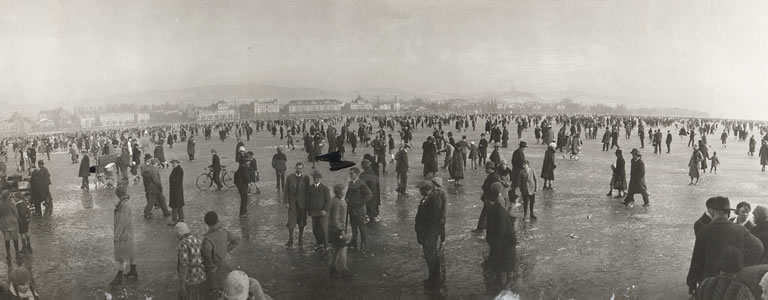Last Monday marked the provisional end to the minor lake freeze for the current winter season. Small lakes like Katzensee in Zurich Nord were cleared for walking on for precisely two days. The low temperatures from 2 to 18 January 2009 raised hopes that it would freeze over. Although it is not always obvious in the first few days of January, the winters have been increasingly warmer in recent years. The prospects of lakes freezing over were and are not good.
Streiff-Becker, Rudolf. Panorama, Seegfrörni 1929. Black-and-white print 9 x 30 cm (Ans 972)
Lake Zurich last froze over in the winter of 1963. Before that, it occurred in 1829/30, 1880, 1891, 1895, 1907 and 1929. It takes just the right climatic conditions for a lake to freeze like that. For instance, the cooling-off process needs to begin as early as possible. Strong, cold winds and clear nights also aid the freeze. A lake needs to cool down to 4 degrees Celsius before it can freeze over. Only if this temperature is reached for an extended period can the lake freeze from the top down. That is when water has its largest density and sinks to the bottom. While smaller lakes freeze more often in cold winters, their larger counterparts like Lake Zurich freeze over only very rarely. In the winter of 1962/63, it was so cold that even Lake Constance froze.
The black-and-white panoramic photograph depicts iceskaters on a frozen Lake Zurich in 1929.
Link: Other images of Lake Zurich frozen over from the years 1891, 1929 and 1963 can be searched for and viewed more closely in the BildarchivOnline with the keyword “Seegfrörni” (frozen lake).

